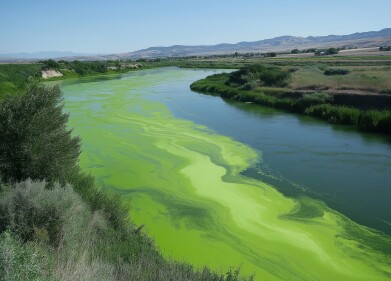Environmental laboratory
Why is NASA Launching a $3.6 Million Project to Monitor Algae?
May 04 2015
Slippery, slimy and seriously sordid, algae definitely doesn’t fall into the category of desirable water plants. Yet from space, water bodies overrun with eukaryotic organisms give off an almost ethereal aesthetic. With their soft colours and swirling patterns, algal blooms look strangely beautiful when captured by satellite cameras orbiting hundreds of miles above Earth. But of course, they pose as a serious threat to the health of humans, animals and the planet as a whole if they’re left to thrive.
NASA to the rescue?
Fortunately the risk has not been left unnoticed, with NASA recently unveiling plans to launch a $3.6 million project that will actively observe and measure freshwater algal blooms across the United States. Using images captured by the agency’s ultra-advanced satellites from as far back as 2002, researchers will use data to combat current blooms, manage future risks and monitor the intensity and regularity of algal blooms. The project is a joint effort by a quartet of organisations – NASA, the Environmental Protection Agency, US Geological Survey and the National Oceanic and Atmospheric Administration.
Algae and the environment
While they may look relatively harmless, algae is actually hugely damaging to the natural environment. The photosynthetic growths absorb carbon dioxide and exude oxygen at an alarmingly high rate. It may be good for the atmosphere but for marine life, too much oxygen can be fatal. When algae dies bacterial populations jump on dissolved oxygen which can then see oxygen levels drop to dangerously low levels. It’s essentially a toxic seesaw.
As well as jeopardising the health of water systems toxins produced by algae can also infiltrate drinking water supplies. Blooms can expand extremely quickly and when they do, the US government is forced to fork out over $64 million a year in management expenses. Last year’s contamination of America’s Lake Erie is a prime example which saw the government shut off taps for several days.
A new dawn for all
For environmental agencies, the new NASA project represents a faster, more accurate way of monitoring the health and algae content of freshwater sources across the nation. This will help prevent growth, as well as boost response times when blooms threaten the health of an ecosystem of community. It also represents a new era for NASA and its database of ocean and freshwater satellite images, with EPA representative Blake Schaffer maintaining that the project is blazing a trail when it comes to linking satellite imagery with the human health record.
As well as monitoring and managing freshwater contaminations, researchers also hope that the satellite data will be used to explore other environmental trends such as climate change and the effects of nutrient runoff on plant growth. Thanks to its broad scope satellite images are an ideal way of uncovering how human and environmental systems react to, and impact each other.
So will NASA achieve its multi-million dollar goal? According to Keith Loftin of the USGS, “the sky is the limit” for satellite data and the potential it has for scientific and environmental research!
How else are NASA measuring water quality to help our environment? Read our article to find out more: Why Is NASA Measuring Rain in America’s Rainiest Place?
Digital Edition
AET 28.4 Oct/Nov 2024
November 2024
Gas Detection - Go from lagging to leading: why investment in gas detection makes sense Air Monitoring - Swirl and vortex meters will aid green hydrogen production - Beyond the Stack: Emi...
View all digital editions
Events
Jan 14 2025 Abu Dhabi, UAE
Jan 20 2025 San Diego, CA, USA
Carrefour des Gestions Locales de L'eau
Jan 22 2025 Rennes, France
Safety, Health & Wellbeing LIVE
Jan 22 2025 Manchester, UK
Jan 25 2025 San Diego, CA, USA



















